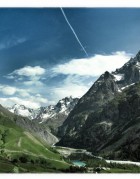The production and transport of oil from unconventional oilfields continues to transform the North American market. This weekend, sadly, we have seen one of the implications of this rapid growth: the Lac Megantic rail disaster.
As of writing at least five people are known to have been killed (and with over 40 still missing this toll is likely to rise), after a runway train carrying 73 tank cars of crude oil rolled into the heart of Lac-Megantic, Quebec, where it derailed and exploded, leveling the town center.
Make no mistake, this is a story about Unconventional oil production, and the cost of our appetite for energy.
Lac Megantic is not the first incident. There have been warning signs, with a series of near misses occurring over the last few months. In March, another Canadian train derailed at Parkers Prairie in Minnesota, spilling 478 barrels of oil. In April, about 20 freight cars, including two that were carrying light sweet crude oil, went off the tracks near White River, Ontario. In May, a freight train jumped the tracks in rural Saskatchewan and spilled more than 572 barrels of oil. In June, there was a near-disaster on the Bonnybrook Bridge in Calgary. The flood-damaged structure had buckled under the weight of four rail cars carrying highly flammable liquids used to dilute raw oil.
This prescient article predicted a rail disaster: http://www.eenews.net/stories/1059982047
As did the National Geographic: http://news.nationalgeographic.co.uk/news/energy/2012/11/121130-north-dakota-oil-trains/
Why have there been so many accidents recently?
Rail freight is actually pretty safe. The American Association of Railroads clam that shipment of oil by rail has fewer and less serious crude oil spills than any other transportation mode, with a spill rate of 0.38 gallons per million barrel miles moved vs. the pipeline ratio of 0.88.
Accidents remain infrequent, but the more oil you move, the more likely an accident.
In 2009, Canadian Pacific moved just 500 carloads of crude oil. By 2011 this had risen to 13,000 carloads. Last year it shipped 53,000 carloads of crude oil. That’s around 34 million barrels of oil, or around 100,000 barrels per day. The growth trend continued into 2013. In January the railroad reached a 70,000 annual carload run rate, and in the first three months of the year Canadian Pacific and Canadian National together hauled nearly 31% more carloads of petroleum than the same period in 2012. Canadian Pacific spokesman Ed Greenberg stated that “Beyond 2013, our railway has a line of sight that is two to three times present volume going forward.” The firm is guiding that it expects between 140,000 and 210,000 carloads of oil in 2016.
In the US the story is, predictably, even bigger. In 2012, shipment of petroleum on US railroads rose 46% to more than 540,000 carloads. In the first few months of this year the US moved 360,000 carloads of crude, 40% up on 2012 again.
In short, we are moving a lot of oil by rail.
Where is all this oil coming from?
It is, of course, an Unconventional Oil story.
Production from Unconventional oilfields continues to soar in the US and Canada. Production from the US Bakken rose to 727,149 barrels per day in April 2013, up 33% from April 2012. Bitumen and liquid oil production in western Canada, in areas such as Athabasca, Peace River, & Cold Lake, along with production from the Canadian part of the Bakken (the geology straddles the border) and regional oilfields together produced ~2.5 million barrels per day in 2012.
All of this oil needs a market, and with production growing so fast that pipelines such as the controversial Keystone XL cannot be built quickly enough the result is simple: rail.
It’s not just shipment of oil to the nearest refinery either. Oil from the Bakken is shipped all over North America, from the West Coast, to the Gulf Coast, to the East Coast. Many analysts said that this was a temporary situation whilst pipelines were built, but commissioning of Enterprise Products & Enbridge Inc’s Seaway pipeline has not meant the end of railway movement. The price of Bakken oil significantly undercuts internationally traded oil such as Brent that used to be delivered by oil tanker to the Atlantic refineries. Today these refineries prefer to face inland, digesting crude shipped by rail from the continental interior. So more oil freight is shipped further.
Today, three quarters of Bakken production is shipped by rail. Warren Buffet’s BNSF is the largest shipper, with Canadian Pacific coming in second. Canadian Pacific is a bigger crude hauler than Canadian National due its rail network near the Bakken oilfields in North Dakota. It was likely that the crude in the Lac Megantic disaster, which originated in the Bakken, was initially shipped by Canadian Pacific & transferred to Montreal, Maine & Atlantic Railway for shipment through Maine to Irving Oil’s 300,000 barrel per day refinery at Saint John, New Brunswick. The train was carrying 73 carloads of oil (47,450 barrels of oil) when it de-railed and devastated Lac Megantic near the Quebec border with Maine. Shipment of oil is a new business for Montreal, Maine & Atlantic Railway. In the first four months of 2013, it carried about 16,500 barrels per day of crude, 10 times more than a year before and up from zero in early 2011.
These disasters are very unlikely, and in general the recovery and shipment of oil is safe. But… every year we extract, ship, and consume more. There is no way to be 100% safe, we can only strive for that goal. As a result, there will, regrettably, be more Lac Megantic disasters, more Deepwater Horizons, more accidents, more spills. It is the price we pay for our energy consumption. The industry must aim for safety, and must ingrain that in its staff and procedures, but we, the consumer, cannot absolve ourselves of responsibility.








